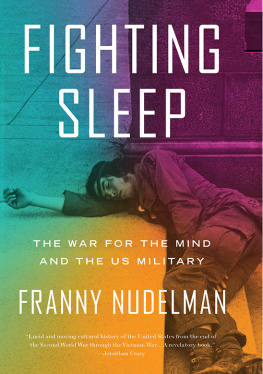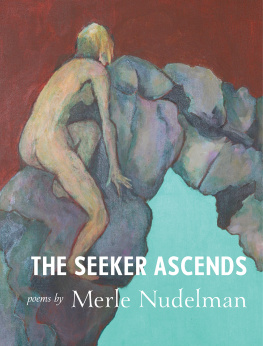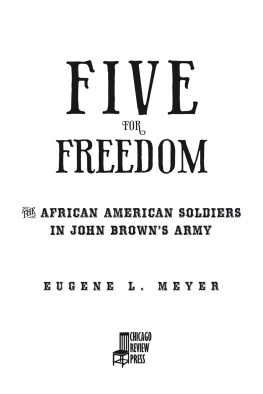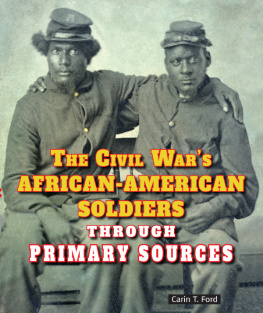JOHN BROWNS BODY
John
CULTURAL STUDIES OF THE UNITED STATES
Alan Trachtenberg, editor
Editorial Advisory Board
Michele Bogart
Karen Halttunen
Mae Henderson
Eric Lott
Miles Orvell
Jeffrey Stewart
John Browns Body
SLAVERY, VIOLENCE, & THE CULTURE OF WAR
FRANNY NUDELMAN
The University of North Carolina Press
Chapel Hill and London
2004
The University of North Carolina Press
All rights reserved
Set in Ruzicka and Melior types by Tseng Information Systems, Inc.
Manufactured in the United States of America The paper in this book meets the guidelines for permanence and durability of the Committee on Production Guidelines for Book Longevity of the Council on Library Resources.
Library of Congress Cataloging-in-Publication Data
Nudelman, Franny.
John Browns body : slavery, violence, and the culture of war / by Franny Nudelman.
p. cm.(Cultural studies of the United States)
Includes bibliographical references and index.
ISBN 0-8078-2883-1 (cloth : alk. paper)
ISBN 0-8078-5557-x (pbk. : alk. paper)
1. United StatesHistoryCivil War, 1861-1865Social aspects.
2. United StatesHistoryCivil War, 1861-1865African Americans.
3. United StatesHistoryCivil War, 1861-1865Literature and the war.
4. Body, Human-Social aspectsUnited StatesHistory. 5. Body, HumanSymbolic aspectsUnited StatesHistory. 6. DeathSocial aspectsUnited StatesHistoryigth century. 7. DeathSymbolic aspectsUnited StatesHistoryigth century. 8. ViolenceSocial aspectsUnited StatesHistoryigth century. g. RacismUnited StatesHistoryigth century. 10. War and societyUnited StatesHistoryigth century. I. Title. II. Series.
E468.9.N84 2004
973.7'Idc22 2003027753
cloth 08 07 06 05 04 5 4 3 2 1
paper 08 07 06 05 04 5 4 3 2 1
A portion of this book was previously published, in somewhat different form, as The Blood of Millions: John Browns Body, Public Violence, and Political Community, American Literary History 14, no. 4 (2001): 639-70. Used with permission.
FRONTISPIECE: Confederate dead gathered for burial.
Alexander Gardner, Antietam, Maryland, September 1862.
Library of Congress.
For Carolyn Porter and in memory of Michael Rogin
CONTENTS
ILLUSTRATIONS
1.1. Carrying Prisoners from the Armory to the Railroad Station
1.2. Trial of Ossawattamie Brown
1.3. The Death of John Brown
2.1. Ethnographic Tableau
3.1. Lincolns funeral procession
3.2. The 25th of April 1865 in New York
3.3. John Miller
3.4. John Millers leg
4.1. Confederate dead by a fence, Antietam, Maryland
4.2. Burying the Dead after the Battle of Antietam
4.3. A Contrast: Federal Buried, Confederate Unburied
4.4. Postmortem, unidentified young girl
4.5. Postmortem portrait, woman holding baby
4.6. Field Where General Reynolds Fell
4.7. The Home of a Rebel Sharpshooter
4.8. Dead Confederate soldier in the trenches, Fort Mahone
4.9. Confederate soldier killed in the trenches, Petersburg
5.1. Patrick Reasons American flag
5.2. Execution of Private Lanahan
5.3. Private William Johnson, executed by a firing squad
5.4. Death to Traitors
5.5. On the Road to Washington
5.6. Agriculture, Manufactures, Fine Arts
5.7. Private William Johnson, executed by hanging
5.8. Gordon, before and after
5.9. A Bit of War History: The Contraband
5.10. A Bit of War History: The Recruit
5.11. A Bit of War History: The Veteran
ACKNOWLEDGMENTS
The love and generosity of friends, family, colleagues, and students made it possible to write this book. It is dedicated to my teachers, Carolyn Porter and Michael Rogin, who taught me how to learn and how to teach, and convinced me that this work matters. Finishing the book in Mikes absence has reminded me that speaking to the dead is a poor substitute for conversing with the living.
My faithful longtime friends have buoyed me up across large distances: Thalia Stanley, Steven Sugarman, Kimberly Moses, Stephanie Hochman, Marcus Verhagen, Carol Lloyd, Hank Pellissier, Gary Wolf, Alan Lyons, Andreas Killen, Johanna Schenkel, and Marlene Saritzky. In New Haven, Charlottesville, and points between, I have been blessed with generous, inspiriting colleagues. My thanks to Nancy Cott, Jean-Christophe Agnew, Michael Denning, Richard Brodhead, Ann Fabian, Matthew Jacobson, Jon Butler, David Waldstreicher, Michael Levenson, Alan Howard, Greg Colomb, Chip Tucker, Elizabeth Fowler, Deborah McDowell, Ed Ayers, Gary Gallagher, Steve Cushman, Gordon Hutner, Carolyn Karcher, Karen Snchez-Eppler, Susie Gillman, and Jackie Goldsby, all of whom have offered vital support, advice, and feedback along the way. Over the years, Jill Campbell, Lanny Hammer, Forrester Hammer, Laura King, Laura Wexler, Bryan Wolf, Beverly Gage, Mike Wigotsky, Marion Rust, Bob Geraci, Dan Rosenzweig, Julie Jones, Matthew and Suzanne Crane, Chris and Brenda Yordy, Susan Fraiman, Eric Lott, Alison Booth, Vicki Olwell, and John OBrien have sustained me with their conversation and friendship. In Corvallis, David Robinson urged me on, while Janet Winston and Laura Belmonte kept me sane and happy. A special thanks to Walter Michaels, who offered indispensable encouragement early on, and to my collaborator Grace Hale, who enabled this work with her careful reading and infectious commitment to intellectual endeavor. From his first warm greeting years ago, Alan Trachtenberg has proved an unparalleled friend and mentor; his faith in the project helped to coax this book into being.
Conversation with countless students informs every page. I owe a special debt to Jaclyn Reindorf, who brought John Browns Body to my attention, to my research assistants Joshua Rowland and Emily Grandstaff, and to Sarah Hagelin for her help with the manuscript in its final stages. I am grateful to Yale University for a Samuel F. B. Morse Junior Faculty Fellowship and to the University of Virginia for a Sesquicentennial Associateship as well as other forms of support. I had the good fortune to complete this book at Oregon State Universitys Center for the Humanities, where I found intellectual companionship, as well as material and emotional support, in abundance. Communities as well as individuals have brought the work along: the Nineteenth-Century American Women Writers Study Group provided inspiration as I began this project, and the Charlottesville Center for Peace and Justice has helped me to put some of the ideas expressed in this book into practice.
John Browns Body has been in sure hands at the University of North Carolina Press. My editor Sian Hunter has offered invaluable insight and guidance at every turn; David Hines has been unfailingly helpful; and Paul Betz has brought his remarkable ear for language, and eye for detail, to the project, making this a better book.
Finally, I thank my family: my brothers, Aaron and David Nudelman, for playing rock music with unbelievable nerve; my dad, Stanley Nudelman, for his love and support; Martin Klein and Suzanne Silk Klein, for their sterling example; Holly and Gerry Wilson, Andrew Norman, Margaret Norman and Geoff Holton, Susan, John, and Sarah Holton, for their warmth and generosity. My mom, Jane Cutler, taught me how to read and write, and how to find meaning in the world around me. Our lifelong conversation gives my work its very shape. If the love of friends and family made it possible to undertake this project, my son and husband have made it possible to finish it. Leo, buoyant and determined, reinvents life from the ground up each day, while David, with unparalleled sweetness and grace, makes this topsy-turvy world feel like home. Together, they have schooled me in the spirit of improvisation and the sense of hope I needed to write this book.











